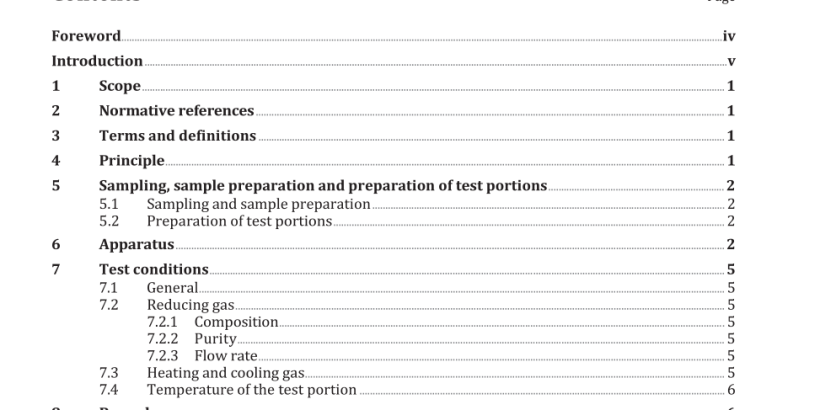ISO 4695:2021 pdf download – Iron ores for blast furnace feedstocks — Determination of the reducibility by the rate of reduction index.
5 Sampling, sample preparation and preparation of test portions 5.1 Sampling and sample preparation Sampling of a lot and preparation of a test sample shall be in accordance with ISO 3082. The size range for pellets, sinters and lump ores shall be −12,5 mm + 10,0 mm. A test sample of at least 2,5 kg, on a dry basis, of the sized material shall be obtained. Oven-dry the test sample to constant mass at 105 °C ± 5 °C and cool it to room temperature before preparation of the test portions. NOTE Constant mass is achieved when the difference in mass between two subsequent measurements becomes less than 0,05 % of the initial mass of the test sample. 5.2 Preparation of test portions Collect each test portion by taking ore particles at random. NOTE Manual methods of division recommended in ISO 3082, such as riffling, can be applied to obtain the test portions. At least five test portions, each of approximately 500 g (± the mass of one particle) shall be prepared from the test sample: four test portions for testing and one for chemical analysis. Weigh the test portions to the nearest 1 g and register the mass of each test portion on its recipient label.
6 Apparatus 6.1 The test apparatus shall comprise the following: a) ordinary laboratory equipment, such as an oven, hand tools, a time-control device and safety equipment; b) reduction tube assembly; c) furnace, equipped with a balance for permitting the mass loss of the test portion to be read at any time during the test; d) system to supply the gases and regulate the flow rates; e) weighing device. Figure 1 shows an example of the test apparatus. 6.2 Reduction tube , made of non-scaling, heat-resistant metal to withstand temperatures higher than 950 °C and resistant to deformation. The internal diameter shall be 75 mm ± 1 mm. A removable perforated plate, made of non-scaling, heat-resistant metal to withstand temperatures higher than 950 °C, shall be mounted in the reduction tube to support the test portion and to ensure uniform gas flow through it. The perforated plate shall be 4 mm thick, with its diameter 1 mm less than the internal diameter of the tube. The holes in the plate shall be 2 mm to 3 mm in diameter at a pitch centre distance of 4 mm to 5 m. Figure 2 shows an example of a reduction tube.
6.3 Furnace , having a heating capacity and temperature control able to maintain the entire test portion, as well as the gas entering the bed, at 950 °C ± 10 °C. 6.4 Balance , capable of weighing the reduction tube assembly, including the test portion, to an accuracy of 1 g. The balance shall have an appropriate device to suspend the reduction tube assembly. 6.5 Gas-supply system, capable of supplying the gases and regulating gas flow rates. It shall be ensured that a frictionless connection between the gas-supply system and the reduction tube does not affect the weight loss determination during reduction. 6.6 Weighing device , capable of weighing the test sample and test portions to an accuracy of 1 g. 7 Test conditions 7.1 General Volumes and flow rates of gases used are as measured at a reference temperature of 0 °C and at a reference atmospheric pressure of 101,325 kPa (1,013 25 bar).
8 Procedure 8.1 Number of determinations for the test Carry out the test as many times as required by the procedure in Annex A . 8.2 Chemical analysis Take, at random, one of the test portions prepared in 5.2 and use it for the determination of the iron(II) oxide content (w 1 ) in accordance with ISO 9035 and the total iron content (w 2 ) in accordance with ISO 2597-1 or ISO 2597-2. 8.3 Reduction Take, at random, another portion prepared in 5.2 and record its mass (m 0 ). Place it in the reduction tube (6.2) and level its surface. NOTE In order to achieve a more uniform gas flow, a double-layer bed of porcelain balls sized between 10,0 mm and 12,5 mm can be placed between the perforated plate and the test portion. Close the top of the reduction tube. Connect the thermocouple, ensuring that its tip is in the centre of the test portion, as shown in Figure 1 . Insert the reduction tube into the furnace (6.3) and suspend it centrally from the balance (6.4) ensuring that there is no contact with the furnace wall or heating elements.
